
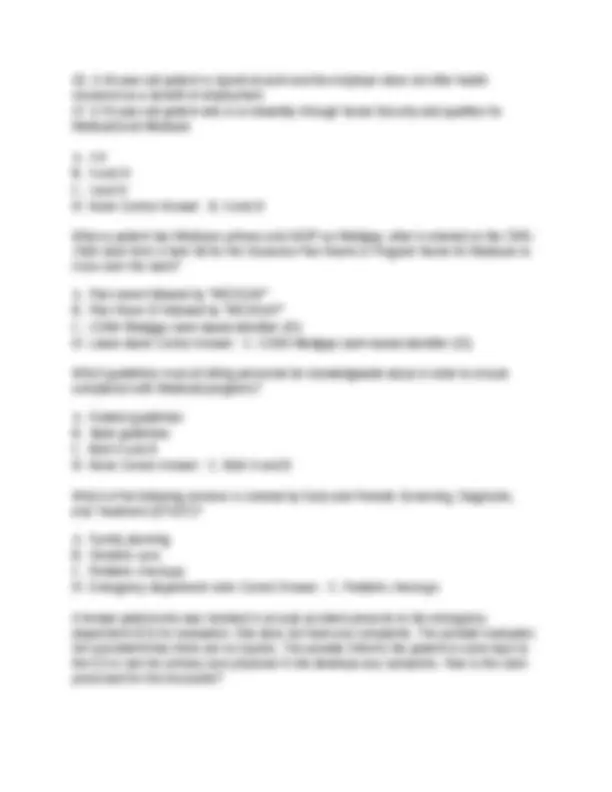
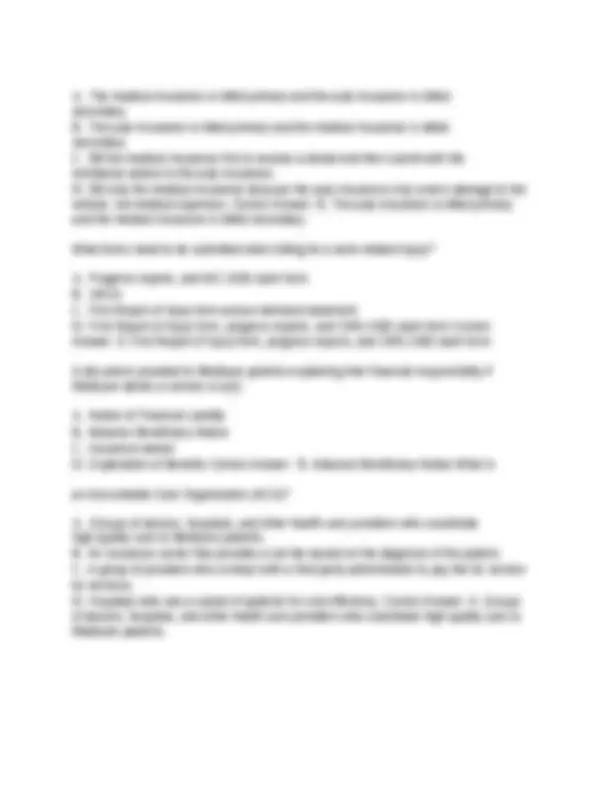
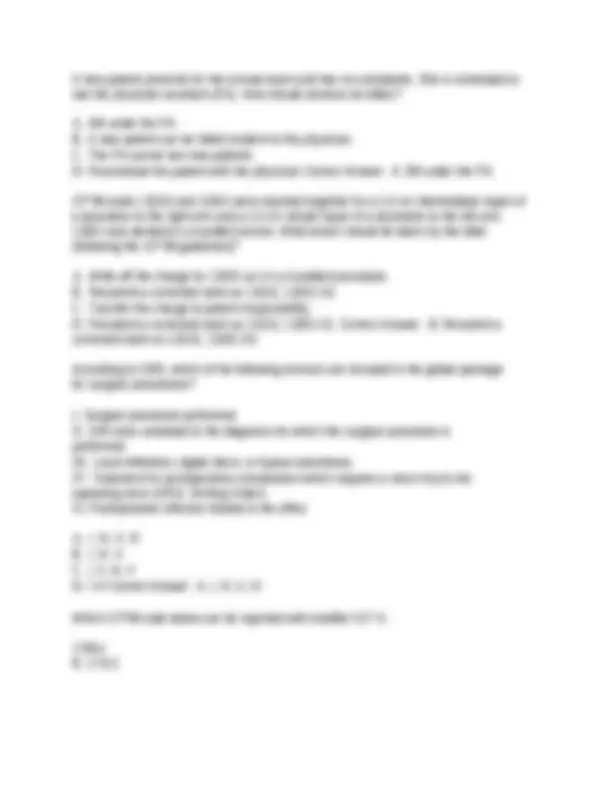
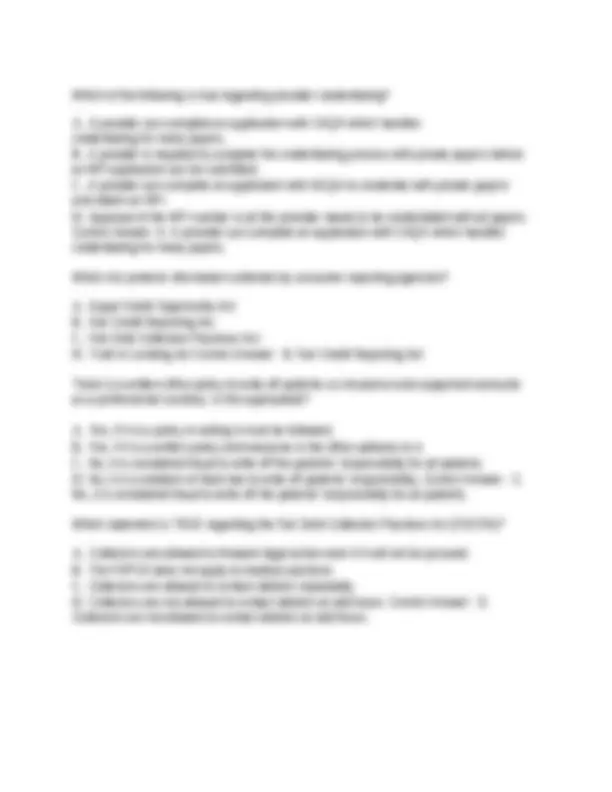
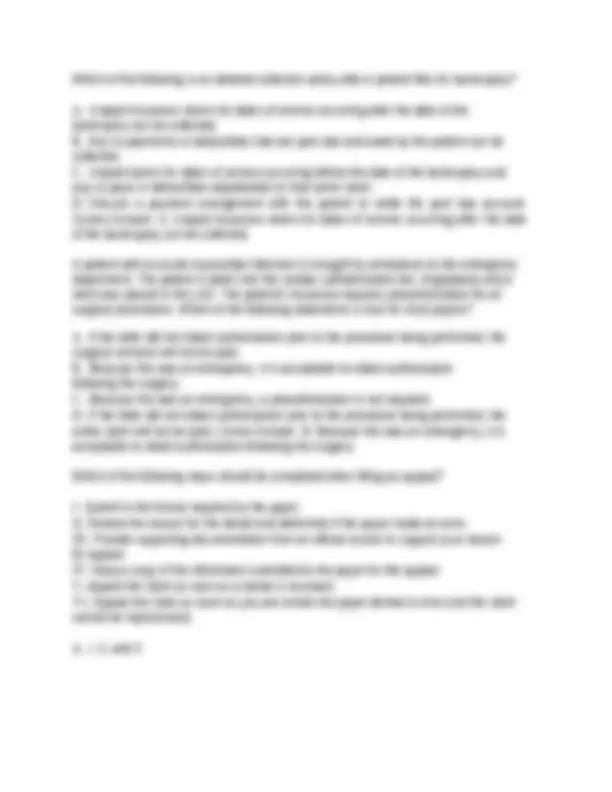
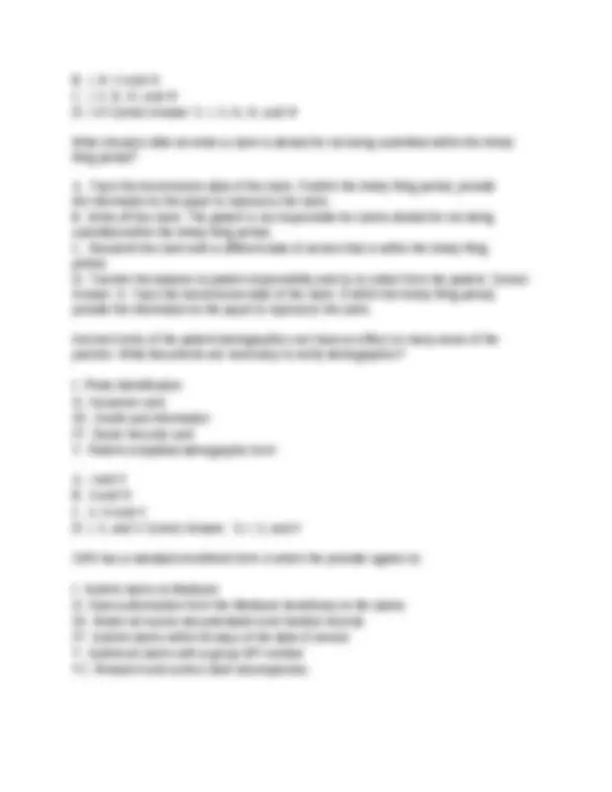


Study with the several resources on Docsity

Earn points by helping other students or get them with a premium plan


Prepare for your exams
Study with the several resources on Docsity

Earn points to download
Earn points by helping other students or get them with a premium plan
Community
Ask the community for help and clear up your study doubts
Discover the best universities in your country according to Docsity users
Free resources
Download our free guides on studying techniques, anxiety management strategies, and thesis advice from Docsity tutors
AAPC CPB Exam A QUESTIONS AND ANSWERS 2025 | RATED A Joe and Mary are a married couple and both carry insurance from their employers. Joe was born on February 23, 1977 and Mary was born on April 4, 1974. Using the birthday rule, who carries the primary insurance for their children for billing? A. Joe, because he is the male head of the household. B. Mary, because her date of birth is the 4th and Joe's date of birth is the 23rd. C. Mary, because her birth year is before Joe's birth year. D. Joe, because his birth month and day are before Mary's birth month and day. Correct Answer: D. Joe, because his birth month and day are before Mary's birth month and day. Which type of managed care insurance allows patients to self-refer to out-of- network providers and pay a higher co-insurance/copay amount? I. HMO II. PPO III. EPO IV. POS V. Capitation
Typology: Exams
1 / 12

This page cannot be seen from the preview
Don't miss anything!







Joe and Mary are a married couple and both carry insurance from their employers. Joe was born on February 23, 1977 and Mary was born on April 4, 1974. Using the birthday rule, who carries the primary insurance for their children for billing? A. Joe, because he is the male head of the household. B. Mary, because her date of birth is the 4th and Joe's date of birth is the 23rd. C. Mary, because her birth year is before Joe's birth year. D. Joe, because his birth month and day are before Mary's birth month and day. Correct Answer: D. Joe, because his birth month and day are before Mary's birth month and day. Which type of managed care insurance allows patients to self-refer to out-of- network providers and pay a higher co-insurance/copay amount? I. HMO II. PPO III. EPO IV. POS V. Capitation A. II B. IV C. II and IV D. II, III, and V Correct Answer: C. II and IV A patient covered by a PPO is scheduled for knee replacement surgery. The biller contacts the insurance carrier to verify benefits and preauthorize the procedure. The carrier verifies the patient has a $500 deductible which must be met. After the deductible, the PPO will pay 80% of the claim. The contracted rate for the procedure is $2,500. What is the patient's responsibility? A. $ B. $ C. $ D. $1,600 Correct Answer: C. $
When a nonparticipating provider files a claim for a patient to BC/BS, how is the payment processed? A. The payment is sent to the patient and the patient must pay the provider. B. The payment is sent to the provider if the provider agrees to accept assignment. C. The payment is sent to the provider regardless if he accepts assignment. D. The claim is not paid because the provider is not participating in the plan. Correct Answer: A. The payment is sent to the patient and the patient must pay the provider. Which of the following TRICARE options is/are available to active duty service members? A. TRICARE Select B. TRICARE Prime C. TRICARE For Life D. TRICARE Young Adult Correct Answer: B. TRICARE Prime A Medicare card will list which of the following: I. Effective date of coverage II. Home address III. Telephone Number IV. Entitled to Part A and/or Part B V. When coverage ends VI. Name of Primary Care Physician A. I - VI B. I, IV C. I-III, VI D. I, II, IV, V Correct Answer: B. I, IV In which of the following scenarios is Medicare the secondary payer? I. A 65 year-old patient who is collecting her deceased spouse's Medicare benefits and has a supplemental insurance II. A 72 year-old patient who participates in the group health insurance of his employer
A. The medical insurance is billed primary and the auto insurance is billed secondary. B. The auto insurance is billed primary and the medical insurance is billed secondary. C. Bill the medical insurance first to receive a denial and then submit with the remittance advice to the auto insurance. D. Bill only the medical insurance because the auto insurance only covers damage to the vehicle, not medical expenses. Correct Answer: B. The auto insurance is billed primary and the medical insurance is billed secondary. What forms need to be submitted when billing for a work-related injury? A. Progress reports, and WC-1500 claim form B. UB- C. First Report of Injury form and an itemized statement D. First Report of Injury form, progress reports, and CMS-1500 claim form Correct Answer: D. First Report of Injury form, progress reports, and CMS-1500 claim form A document provided to Medicare patients explaining their financial responsibility if Medicare denies a service is a(n): A. Notice of Financial Liability B. Advance Beneficiary Notice C. Insurance waiver D. Explanation of Benefits Correct Answer: B. Advance Beneficiary Notice What is an Accountable Care Organization (ACO)? A. Groups of doctors, hospitals, and other health care providers who coordinate high quality care to Medicare patients. B. An insurance carrier that provides a set fee based on the diagnosis of the patient. C. A group of providers who contract with a third party administrator to pay fee for service for services. D. Hospitals who see a subset of patients for cost efficiency. Correct Answer: A. Groups of doctors, hospitals, and other health care providers who coordinate high quality care to Medicare patients.
A new patient presents for her annual exam and has no complaints. She is scheduled to see the physician assistant (PA). How should services be billed? A. Bill under the PA. B. A new patient can be billed incident to the physician. C. The PA cannot see new patients. D. Reschedule the patient with the physician Correct Answer: A. Bill under the PA. CPT® codes 12032 and 12001 were reported together for a 2.6 cm intermediate repair of a laceration to the right arm and a 2.5 cm simple repair of a laceration to the left arm. 12001 was denied as a bundled service. What action should be taken by the biller (following the CPT® guidelines)? A. Write-off the charge for 12001 as it is a bundled procedure. B. Resubmit a corrected claim as 12032, 12001-59. C. Transfer the charge to patient responsibility. D. Resubmit a corrected claim as 12032, 12001-51. Correct Answer: B. Resubmit a corrected claim as 12032, 12001-59. According to CMS, which of the following services are included in the global package for surgical procedures? I. Surgical procedure performed II. E/M visits unrelated to the diagnosis for which the surgical procedure is performed III. Local infiltration, digital block, or topical anesthesia IV. Treatment for postoperative complication which requires a return trip to the operating room (OR)V. Writing Orders VI. Postoperative infection treated in the office A. I, III, V, VI B. I, IV, V C. I, II, III, V D. I-VI Correct Answer: A. I, III, V, VI Which CPT® code below can be reported with modifier 51? A. 17004 B. 17312
D. Consumer Credit Protection Act Correct Answer: C. False Claims Act Security involves the safekeeping of patient information by: I. Setting office policies to protect PHI from alteration, destruction, tampering, or loss II. Allowing full access to all employees to the electronic medical records III. Giving employees a policy on confidentiality to read IV. Requiring employees to sign a confidentiality statement that details the consequences of not maintaining patient confidentiality, including termination A. I and IV B. I, II, and IV C. II, III, and IV D. II and III Correct Answer: A. I and IV Dr. Taylor's office has a new medical assistant (MA) who is responsible for blood collection for lab specimens. Because the MA is new, she often misses when obtaining blood on the first stick. To be sure the office is billing for all services, the office now has a rule that all patients will be billed a minimum of two blood draws to demonstrate the work that is being done for lab collection. Which statement is true regarding this rule? A. The rule covers the office and allows them to get paid for all services performed. B. The rule is fraudulent because the office is billing for services not performed and services that are a result of provider error. C. The rule would be legal if changed to only bill for two blood draws on the patients the MA misses on the first stick. D. The rule is only legal if the clinic is in a hospital-based office. Correct Answer: B. The rule is fraudulent because the office is billing for services not performed and services that are a result of provider error. An example of an overpayment that must be refunded is? A. Payment based on a reasonable charge. B. An unprocessed voided claim. C. Incorrect posting of an EOB. D. Duplicate processing of a claim Correct Answer: D. Duplicate processing of a claim
Which of the following is true regarding provider credentialing? A. A provider can complete an application with CAQH which handles credentialing for many payers. B. A provider is required to complete the credentialing process with private payers before an NPI application can be submitted. C. A provider can complete an application with NCQA to credential with private payers and obtain an NPI. D. Approval of the NPI number is all the provider needs to be credentialed with all payers. Correct Answer: A. A provider can complete an application with CAQH which handles credentialing for many payers. Which Act protects information collected by consumer reporting agencies? A. Equal Credit Opportunity Act B. Fair Credit Reporting Act C. Fair Debt Collection Practices Act D. Truth in Lending Act Correct Answer: B. Fair Credit Reporting Act There is a written office policy to write off patients co-insurance and copayment amounts as a professional courtesy. Is this appropriate? A. Yes, if it is a policy in writing it must be followed. B. Yes, if it is a written policy and everyone in the office adheres to it. C. No, it is considered fraud to write off the patients' responsibility for all patients. D. No, it is a violation of Stark law to write off patients' responsibility. Correct Answer: C. No, it is considered fraud to write off the patients' responsibility for all patients. Which statement is TRUE regarding the Fair Debt Collection Practices Act (FDCPA)? A. Collectors are allowed to threaten legal action even if it will not be pursued. B. The FDPCA does not apply to medical practices. C. Collectors are allowed to contact debtors repeatedly. D. Collectors are not allowed to contact debtors at odd hours. Correct Answer: D. Collectors are not allowed to contact debtors at odd hours.
B. I, IV, V and VI C. I, II, III, IV, and VI D. I-VI Correct Answer: C. I, II, III, IV, and VI What should a biller do when a claim is denied for not being submitted within the timely filing period? A. Track the transmission date of the claim. If within the timely filing period, provide the information to the payer to reprocess the claim. B. Write off the claim. The patient is not responsible for claims denied for not being submitted within the timely filing period. C. Resubmit the claim with a different date of service that is within the timely filing period. D. Transfer the balance to patient responsibility and try to collect from the patient. Correct Answer: A. Track the transmission date of the claim. If within the timely filing period, provide the information to the payer to reprocess the claim. Incorrect entry of the patient demographics can have an effect on many areas of the practice. What documents are necessary to verify demographics? I. Photo Identification II. Insurance card III. Credit card information IV. Social Security card V. Patient completed demographic form A. I and V B. II and IV C. II, IV and V D. I, II, and V Correct Answer: D. I, II, and V CMS has a standard enrollment form in which the provider agrees to: I. Submit claims to Medicare II. Have authorization from the Medicare beneficiary to file claims III. Retain all source documentation and medical records IV. Submit claims within 60 days of the date of service V. Submit all claims with a group NPI number VI. Research and correct claim discrepancies.
A. I, II, and IV B. II, IV, and V C. I, III, IV, and VI D. I, II, III, and VI Correct Answer: D. I, II, III, and VI Ms. Turner had surgery one month ago for hernia repair. She is still in the post- operative period and comes in today to the see the same physician that performed the hernia repair surgery about a lump that she noticed on her tailbone. The physician performs an examination and the diagnosis is that she has a pilonidal cyst which is unrelated to the surgery. Can the physician bill an E/M service for today's visit during the post-operative period? A. Yes, the E/M service can be reported with modifier 24 to indicate it is unrelated to the surgery. B. No, because the examination falls in the post-operative period of the original procedure. C. No, report code 99024 instead of the E/M service for all services provided in the post- operative period. D. Yes, the E/M can be reported with modifier 25 to indicate a separate procedure or service was performed. Correct Answer: A. Yes, the E/M service can be reported with modifier 24 to indicate it is unrelated to the surgery. When you respond to a patient with "How may I help you, Mrs. Jones?", the use of the patient's name: A. Is too familiar B. Violates HIPAA C. Indicates to the caller you are interested and listening D. Is too formal for an existing patient Correct Answer: C. Indicates to the caller you are interested and listening A dermatologist performed an excision of a squamous cell carcinoma from the patients forehead with a 1.2 cm excised diameter. The excision site required an intermediate wound closure measuring 1.8 cm. What is/are the correct code(s)? A. 11642 B. 11442 C. 11642, 12051- D. 11442, 12051-51 Correct Answer: C. 11642, 12051-